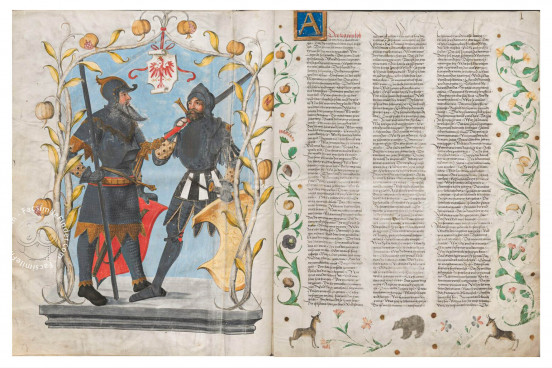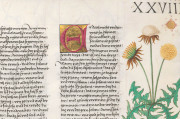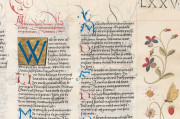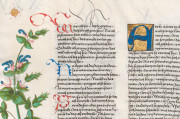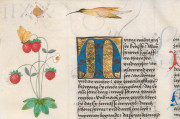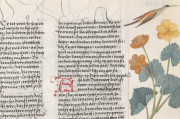The Ambras Book of Heroes is a selection of poems in Middle High German, compiled and copied in South Tyrol between 1504 and 1516 by Hans Reid for the Holy Roman Emperor Maximilian I. Of the twenty-five poems, fifteen are preserved only in this manuscript. The poems, which date from the twelfth and thirteenth centuries, are mostly heroic and courtly epics. A full-page frontispiece depicting two knights reflects the patron’s interest in chivalry. The manuscript is beautifully decorated, with many meticulously rendered marginal images of flora, fauna, and figures.
This remarkable manuscript encompasses numerous significant Middle High German epics, including the renowned Nibelungenlied, Hartmann's Erec and Iwein, and Ulrich of Lichtenstein's Frauenbuch. Commissioned by Emperor Maximilian I for his personal collection, the manuscript was meticulously copied by Hans Ried, who served as customs officer on the Eisack near Bolzano.
A Giant Book of Calligraphic Excellence
Often referred to as the "giant book" due to its imposing dimensions (406 x 360 mm), the creation of this manuscript required the skins of no fewer than 122 calves. What distinguishes this codex is the remarkable consistency and beauty of its script, which maintains uniform lettering throughout its entirety. The manuscript's 486 pages (243 folios) are further enhanced by 118 pages adorned with elaborately painted initials and imaginative marginal decorations, establishing it as an invaluable document for both literary and art historical scholarship.
The manuscript exhibits exceptional calligraphic artistry, with Hans Ried employing German cancelleresca script with masterful precision. The consistent execution of this script throughout the entire codex imparts a distinctive character to the work, such that it merits recognition in scribal history as its own style—the script of the Book of Heroes.
A distinctive feature of Ried's handwriting is the abundant use of hair-fine diacritic marks, which have frequently challenged scholars attempting to transcribe texts from the Ambras Book of Heroes using reduced-size reproductions or film copies.
Dedication and Craftsmanship
The transcription of the Ambras Book of Heroes consumed over twelve years—an extensive period even for a manuscript of such substantial proportions. While Ried was occasionally characterized as a "clever lazybone," such criticism appears unwarranted, considering that he was simultaneously engaged with other projects. Furthermore, the exceptional diligence he demonstrated in executing both the script and the elaborate decoration of first and last lines on each page suggests that his maximum daily output likely did not exceed three columns (equivalent to one page).
Decorative Elements and Artistic Merit
The manuscript's decorative apparatus comprises numerous small initials, likely added subsequently by a specialized rubricist, while the larger initials were executed by a single artist in one campaign. These larger initials appear in various colors, predominantly red or blue, against finely patterned golden backgrounds, with some rendered in luminous gold against colored backgrounds.
The margins of 118 pages feature imaginative ornamentation dispersed across their breadth. The naturalistic and detailed execution of various plants, animals, and human figures reveals the hand of an accomplished master who appears to have adapted certain motifs, with creative variation, from illuminated books of hours from the Low Countries.
These marginal decorations serve not merely as ornamental embellishments but occasionally establish direct connections with the text. A notable example occurs on folio 212v, where the depiction of a sword broken against a dragon's scale armor visually reinforces the narrative described on the same page.
Imperial Patronage and Symbolism
The frontispiece of the Ambras Book of Heroes depicts two armored men, presumably heroes standing guard at the entrance to the eponymous book. The manuscript also contains visual references to its imperial commissioner, particularly through the inclusion of pomegranates—one of Maximilian's personal emblems. These motifs might be interpreted as symbolic transformations of the imperial orb, alluding to the emperor's worldly dominion.
We have 1 facsimile edition of the manuscript "Ambras Book of Heroes": Ambraser Heldenbuch facsimile edition, published by Akademische Druck- u. Verlagsanstalt (ADEVA), 1973
Request Info / Price
